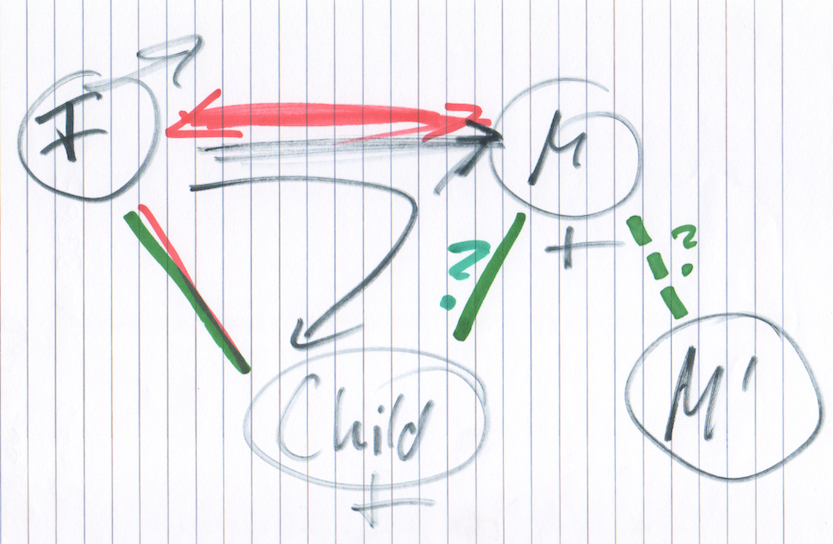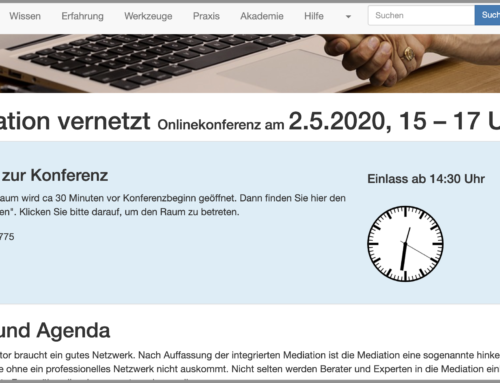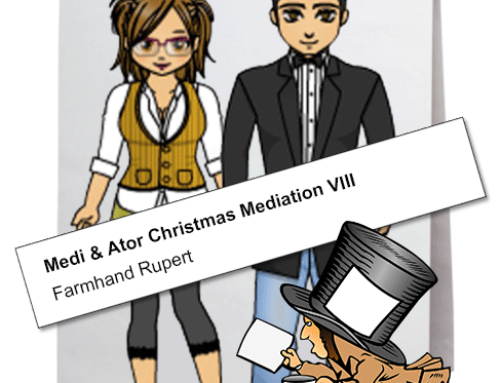A map shows the landscape, roads and much more. What is the concern of conflict maps? It’s the same. They visualize conflicts where we have systems, elements and an environment to be respected, influencing, impacting and interacting with each other, just as system theory explains. And why do we need that in mediation?
Because it helps.
A valid conflict map will visualize the dynamic behind the conflicts. Mediation might use it while rather working with than against the dynamic of conflicts. Additionally mediation is a process of clarification where clearness is needed for understanding and understanding is what needs to be mediated. If we are working like professionals, then every mediation starts with a conflict analysis. This is a must in so called transformative mediations. Transformative mediations aim in overcoming the conflict not just the problem. The simple insight therefore is:
We can only overcome what we are able to see.
The next simple insight is:
As the parties should resolve their conflict on their own THEY need to see it.
The mediator just helps them doing so. To make the conflict visible, we should be able to identify it. Not knowing who has conflict about what with whom wouldn’t help bringing structure and clearness into the talks we want us to guide through mediation. The conflict analysis is important:
- firstly to organize the mediation,
- secondly to identify the conflict and
- thirdly to thematize what we should talk about.
It appears to be a phenomenon of conflicts to show up anywhere but not where they are from. Conflicts are tricky. You might compare them with water dropping from the ceiling. You should not imagine the lack in the roof is straight over the drops. Water takes a long way before it finds the weakest point where to get out. First there are some drops. If you close the hole in the ceiling but not the lack in the roof, they will drop down somewhere else. The water will find its way. Somewhere else it will find another weak point in the ceiling and there are some drops falling down again. If you do not find the lack in the roof more water will follow until a flood falls down into the living room and leisure time definitely is over. Finding a sustainable solution now means to find the hole in the roof not just to stuff the hole in the ceiling.
Conflicts behave the same way. We should not believe that the symptoms becoming visible are determining the conflict. They are just indications. Healing the symptoms will not be sustainable. This might be compared with stuffing the hole in the ceiling instead of repairing the roof. Conflicts will keep running in behind. They will show up other symptoms along the conflicts life-time. Symptoms of conflict are like hints as if to say: “Try to find me”. Obviously conflicts like that hide and seek game.
On the first glance erasing the symptoms makes the conflict invisible but on the second glance it doesn’t resolve it.
If mediation aims to overcome a conflict we shouldn’t trap in those symptoms but become aware of the real conflict running behind. This is the motor driving people to that madness they are wasting energy for. What mediation is doing in that conflict game – by the way – is trying to turn it around. To not let the conflict be the game leader but the players. To not be played by the conflict but to play with the conflict is the concept behind. That’s the game we are going to play in mediation (if you like to see it from that point of view). This is what we call working WITH the dynamic of conflicts by using it. It is where we try to empower people to self-responsibility and regaining control.
For all of those reasons a conflict analysis is a crucial tool accompanying the mediator alongside the whole mediation. It happens behind the curtains just in the mediator’s brain, innocent, decently, calm and without any validation.
Conflict analysis helps us identifying the conflict.
For analyzing the conflict we need to know:
- the dimension of the conflict (the type of conflict),
- the persons involved (directly or indirectly)
- the degree of the conflict’s escalation.
Being aware of that is a must in professional mediation. It is a standard of integrated mediation. Maybe that sounds simple now. But we have to be careful. Conflicts are tricky. Disguising themselves is their survival strategy.
If we want to overcome conflicts we should disclose them.
Conflicts behave like “Rumpelstilzchen” in that German fairy tale of brothers Grimm. “Rumpelstilzchen” was an evil demon. You might take that demon an equivalent of conflicts. We use to treat conflicts like demons. “Don’t talk about” is what we learned. We use to hide from conflicts. We behave like little children. They close their eyes and believe they are invisible now as they do not see anything anymore. Demons are scary. Seems to be more comfortable to not look at them. Unfortunately not looking at the conflict doesn’t help avoid it – at least not always. In that fairy tale of brothers Grimm, the princess was forced to face Rumpelstilzchen. She couldn’t avoid Rumpilstilzchen as the demon used to just appear without being invited when it wanted to scare the princess. Nevertheless she became rid of it, in that moment when she was able to call its name. The fairy tale now tells how Rumpelstilzchen started to curse. “This was the devil telling you, this was the devil telling you” it screamed all the time. Then it teared itself and was not seen anymore. What we learn is:
Naming the conflict is providing a happy end.
Exactly that is what we try to achieve in transformative mediation. But there is a challenge. It must be the princess – the parties in our case – who call the demon’s name. Parties need to explore it themselves. It wouldn’t help if we call the name instead of the parties. If they call it, the same happens like in that fairy tale. Rumpelstilzchen destroys itself. The conflict vanishes. The wisdom we take out of that is:
The demon is no longer a scary demon when it is known.
Rumpelstilzchen’s name by the way is NOT like blaming what’s wrong with the other side. This is the name parties know pretty well. They believe that should be Rumpelstilzchen’s name. But they are wrong. It’s not Rumpelstilzchen’s real name. The real name is addressing self-concern, self responsibility, self-confidence – briefly it is addressing oneself instead. We use the windows 1 technique to steer the party’s focus on themselves. “I am not that much interested to learn how you think about the opponent. More I am interested to learn how you think about yourself” we tell the parties. If they become able to call that real demon’s name, the demon, who became the conflict’a avatar, cannot survive. That phenomenon you can observe quite often happening in mediation. There is resistance first to look into the demon’s face. But when it happened it is proved as something releasing the parties. It’s the price they have to pay for regaining control. The way getting to there has been described like “passing the snake-pit” in that guide through mediation. Where the conflict is going deeper the demon will not vanish immediately. Nevertheless parties will have a mark and an address to going the first step overcoming it. For that reason one of our aims in mediation is, to let the parties recognize and accept their conflict as it is.
This is another crucial reason why mediators should know who is concerning what in conflict with whom. The question WHY is absolutely obsolete. People use to be curious for that. It needs some trainings to not fall back into that investigative thinking. It is important to not being curious for reasons, as we want to steer the parties’ mind not to the lacks where they will land if we ask them WHY things are as they are. They immediately will fall back into phase 2 if we allow that kind of thinking. We take care that thoughts can go into the other direction. We help parties to get out of a thinking we have been trained by our education and culture. We help them by saying: “You do not need to explain why things went wrongly. You do not need to justify yourself and you do not need to argue. I am not interested what you are thinking about the other side. I am interested in YOU and in what it makes with YOU. I therefore prefer you tell me how YOU want to be that things can go the right way”.
Mediation is the only process I know, able to deal with huge complexities.
The means doing so is to structure and isolate everything in smaller portions and pieces. Precise listening is the technique behind. It helps parties to precisely think in very little steps but forward not backwards. You might comparable this way of thinking with the juridical method called “subsumption”. Just the direction of using it is different. Opposite to jurists we do not head our thinking to the past but to the future. Opposite to jurists we do not limit our interest in what the law is saying. Opposite to jurists we do not reduce it to facts only. We have everything in mind. facts, emotions opinions and many more dimensions (for example: relationships, relationship-levels, justice, religion,. culture,…. wherever is influencing the problem). We are thinking without limits and we are interested in everything. Just to understand the whole truth and not just parts of it. We try to understand what is visible and additionally what stays invisible. The truth (or let’s say the construct of reality) is made from those both sides and even more.
Nevertheless the method almost is the same like subsumtion. We use it to divide the world of thinking of each party into handy pieces. Small pieces are big enough for our brain to work with. They become like pieces of a mosaic which later, after we understood to where they belong, will be added again for drawing the full scale picture. This picture will be different then before as it is more precise and detailed, covering more information.
The idea is to simply merge simplicity.
Maybe it becomes a bit clearer now, why we, integrated mediation, define mediation as to be a cognition process. Mediation includes so many cognition steps steering of mind and thinking that is necessary to overcome the conflicts. I also think there are enough reasons now, to explain why we have to face the conflict as it is and not as it appears to us.
Drawing a conflict map is the tool to visualize conflicts.
This is to not just understand the conflicts but also the dynamic behind. A map tells a lot. There are towns, roads, cardial directions, environments, cross roads and more. We even can see if there are big roads or small roads. If there are roads with a lot of traffic or just made for pedestrians, deadlocks, one way roads, and so on. Now we take that tool to identify the landscape of conflicts the same way. I’ld like to explain that by an example.
Let’s take a couple in divorce with a child. They are quarreling about the custody right, father’s contact with child and child maintenance. These are three issues mentioned, we collect in phase 2. The mediator recognizes the way how the couple is dealing with each other. It is obvious that they hate each other. He might mirror that. Now parties will have the chance to agree and maybe that couple conflict becomes the fourth issue. Probably this is impacting the other queries parties have. We built hypotheses about that picture and imagine it might be that couple conflict, that hating each other, becoming a main motor of all that mess. Now we have the situation like follows:
- 1. issue: hate of the couple – this refers the relationship dimension where the conflict partners are wife and husband. The mediator will note that like the issue “dealing with each other”. This way of fixing that issue shows the purpose why talking about.
- 2. issue: custody right – this probably is an outcome of that relationship conflict registered as issue 1 already. But maybe there is more behind. It could be another relationship conflict. It could be a conflict still between that couple but on the parent’s level, which is another dealing. Then we have two persons again. It also can be seen a relationship conflict between father and daughter. Then we have two other persons. Or it is a conflict even between mother and daughter effecting the relationship between father and daughter. Now we have two other persons eventually three. It might become clear now that it makes a difference to talk about the one or the other. And it should become clear that talking about the wrong things with wrong persons will mislead the mediation..
- 3. issue: The father’s contact query might be seen as variant like the 2nd issue.
- 4. issue: Who is in conflict in regard of that child maintenance quest? Now it again might be the appearance of that couple conflict mentioned under issue 1. It also can be an appearance of that relationship conflict between the parents. It can be caused by those relationship conflicts between father and daughter or mother and daughter and it can be additionally an inner conflict of the mother, who is worrying about the earning of her living and so on.
Now that looks like a lot of stuff. We are thinking in hypotheses. That means this all is possible – theoretically at least – but must not be real. We’ll have to find that out. More precisely: Parties will have to find that out. For that it’s good to take everything possible into consideration. Right now we have to face that the parties’ conflict described in 4 issues might be separated into around 10 (I didn’t count the options) different conflicts. Too many for our small human’s brain. We therefore try to find the causes with the highest likelihood. This will be the issue we should talk about first. If we focus the problems like that our talks will be portioned and therefore easier. There is another advantage coming out of that because we now also know whom we have to address in our talks – or better said: whom we have to invite.
The rule is: Make things simple by isolating the issues and the people involved.
You ask how we find out the highest likelihood and the leading conflict? Now we use the map tool again. If we would draw all the ideas we collected before, we would have some points marking the people and we have lines marking relationships according to the conflict between them. Compared with a map we could draw dominant people like big towns, people depending from them like suburbia or small villages. The strengthen of relationship, we could draw like highways and the escalation of conflict in those different relationships we could draw like railways. We even can give directions in our drawing showing up who is impacting whom. The idea behind is to find the conflict motor behind all that mess. We want to find out the dynamic behind. Who is how interacting with whom causing which kind of troubles. The result of such a drawing might look like the picture below.

It’s a challenge drawing conflict maps as they will change their face during the mediation. Opposite to land-maps or town-maps they are not static. A conflict map does’t need to look nice. At least it is enough, if it just is painted in mediator’s mind.
In our example we see that thick red line between husband and wife. It marks the relationship conflict where is hate. The curve below shows a redirected conflict starting at the father going over the mother landing at the child. This might express what we call PAS ( Parentel Alienation Syndrom). It’s an appearance of conflicts that are shown up in relationships between father and child but caused by an inner conflict of the mother or the couple’s relationship-conflict as well.
What we achieve that way is an idea of the variety of conflicts which could impact the problem. What we also gain is a structure how to get through those conflicts. We go through them by trial and error and step by step. We proceed very logically and not forgetting anything. This, by the way, is the strategy computer specialists use to find out the reason for PC damages. The method is to disclose reasons until the last reason stays which then might be identified as to be the reason causing all that disaster.
Because in our example we believe, the couple relation-conflict is the one on the highest leveled conflicts, we understand that the conflict partners to talk with are husband and wife. For that conflict we do not need that child. We also know the issue we have to talk about first.
Now we step into phase 3 of mediation, where we address this single conflict.
Don’t forget. We are no psychotherapists and we are no psychoanalysts. For that we do not care that much of the conflict. If that is not becoming necessary we even do not talk about. We ask an initial question that let parties indirectly talk about. Directly we ask them to draw the world how it should be. As relationship is the problem we ask them: “What is the meaning of relationship of a couple in divorce like you?”. Parties do have enough opportunity now to talk about their conflict. But they are not asked doing so. Their reactions will show us how deep the conflict is burned into their mind. Our question heads into the future. That is meant to switch brain and thoughts away from the conflict and not into it. “How do you think the relationship between you as a divorced couple should be?”. If that is clear we can step to phase 4.
In phase 4 we ask: “Now you have an idea how the world should be. I am curious to learn how you think to get there now”. This is steering parties brain to resolving the conflict by not focussing it. That is the reason why mediation is much quicker sometimes than therapy or other methods. That is why people feel like: “It was not that bad as I thought talking of our conflict when we started the mediation”.
There is another insight mediators learn in almost every mediation. The wisdom is:
The reason why things are as they are doesn’t matter at all.
What matters solely is the question how do we get to where we can satisfy our needs. Nothing more counts. Brain mostly is not able to answer that question. It’s a question addressing heart and maybe stomach. It’s addressing the other centers of human intelligence as there are: emotional intelligence and instinct available also beyond the brain.
Maybe you now understand why thinking in terms of mediation is relaxing so much.
The idea of integrated mediation is that this way of thinking is possible everywhere.
Not only in dedicated cases of mediation. Mediation describes a cognition process. You even can take it a philosophy. It’s a wisdom we can use in our own lives therefore as well. Facts are as they are. What we make out of them is determining the future. The interactions coming out of that are creating it. We can draft future in that moment, when we dissolve our thinking from thinking in reasons and solutions. People never get what they want (= solution), but always what they need (= satisfaction). Hate by the way is providing some satisfaction. In the moment we understand for what it is good for (if we know the need behind), we are able to exchange the means to find satisfaction by another mean that is more constructive.
Life could be so easy. Now I wonder what is the need we try to satisfy by making it so complicated? Let’s draw a conflict map around, then we will see.






Leave A Comment
You must be logged in to post a comment.